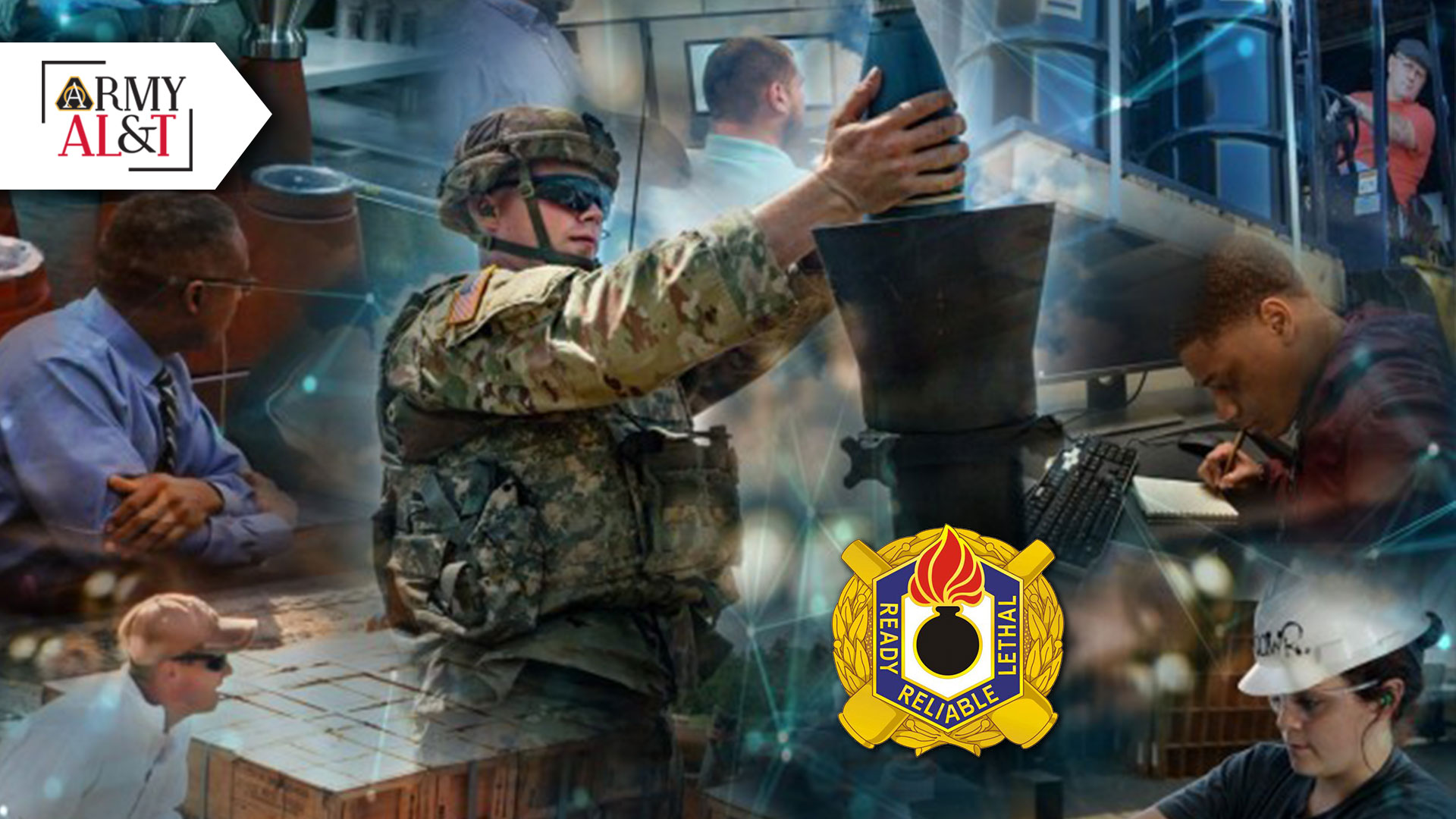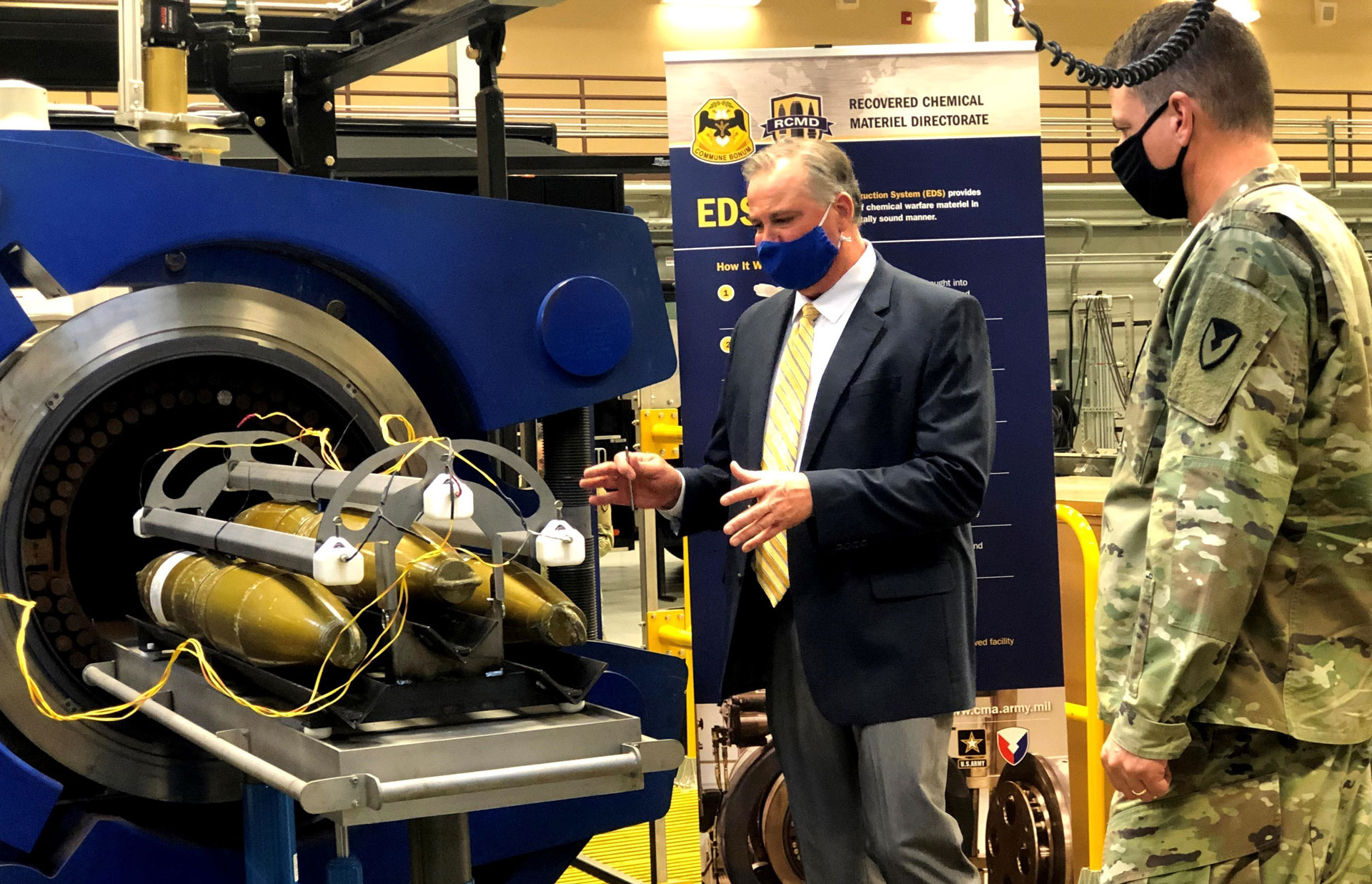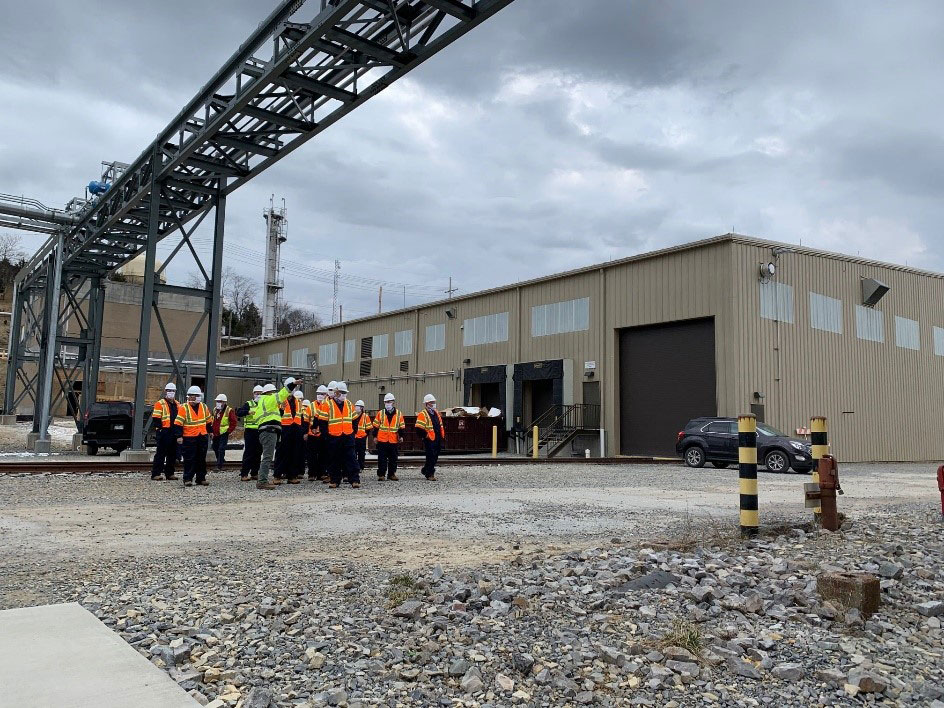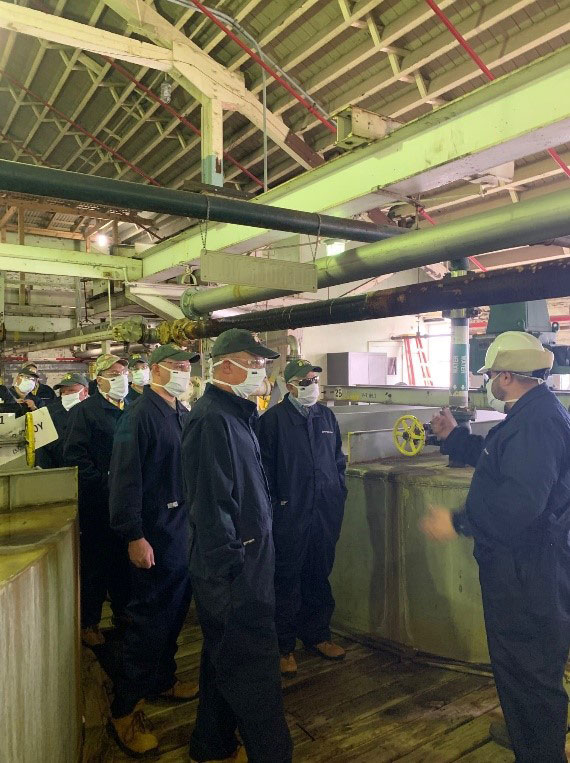
FUTURE VISION: JMC’s revised ammunition strategy will build a 21st century organic industrial base capable of sustaining fielded systems, maintaining pace with Army modernization efforts, and able to support the global scope of large-scale combat operations. (Graphic by Courtney Maxson)
JMC approach to modernization includes places, processes and people.
by Col. Gavin J. Gardner
As the U.S. Army Joint Munitions Command (JMC) adapts to maintain constant readiness in its mission to provide munitions to the joint forces, it recognizes that modernization is not a simple matter of ensuring that the military remains up to date in terms of war technology. It also must ensure modernization of its facilities, processes and workforce to respond to future needs. With these issues in mind, JMC’s revised ammunition strategy drives to an end state of a 21st century organic industrial base—composed of resource providers, acquisition and sustainment planners, and manufacturing and maintenance performers—capable of sustaining fielded systems, maintaining pace with Army modernization efforts, and postured to surge in support of the wide-ranging, global scope of large-scale combat operations.
As Gen. Edward M. Daly, commander of Army Material Command (AMC) has emphasized, “The purpose of the ammunition organic industrial base is to support current munitions readiness, maintain surge capacity and capability, and modernize to support future weapons platforms.”

ON TOUR: Chemical Materials Activity (CMA) Deputy Director Laurence G. Gottschalk briefs the author about the explosive destruction system during a tour of CMA in March. (Photo by Sarah Lobos, Army Chemical Materials Activity)
According to Dr. Bruce D. Jette, former assistant secretary of the Army for acquisition, logistics and technology (ASA(ALT)), “The Army is eying a 15-year, $16 billion strategy to automate and improve the military’s ammunition manufacturing process.” JMC, as the logistics integrator for life cycle management of ammunition, is collaborating with the Army, ASA(ALT), AMC and the Joint Program Executive Office for Armaments and Ammunition (JPEO A&A)—which leads the development, procurement and delivery of ammunition and armaments—on this path forward.
AMC’s 15-year organic industrial base modernization strategy includes four key phases:
- Identification—Identify 21st century technology for the future organic industrial base.
- Evaluation—Evaluate how the new technology identified in the identification phase could potentially improve operations in the organic industrial base.
- Analysis—Determine the pros and cons of the new technology, develop a priority list of technology, create a sustainment plan and update area development plans.
- Execution—Implementation plan, project lists.
Taking its cues from the AMC strategy, JMC has developed a three-level transformation framework.
- Level 1—Codify core competencies (production, distribution, storage and demilitarization) by site.
- Level 2—Develop the transformation strategy, conduct workshops, develop projects and determine costs.
- Level 3—Establish time-phased project requirements, aligning ongoing projects with the transformation strategy on a site-by-site basis.

QUALITY ASSURED: JMC will maintain its core mission throughout the modernization process, ensuring quality munitions while building a better future. (Photo by Hayley Smith, Crane Army Ammunition Activity)
JMC’s improvements must align with the essential characteristics of a safe and modernized ammunition organic industrial base:
- A transformed workforce.
- A single point of failure mitigation.
- Robotics.
- Remote-operating capabilities.
- Prognostic and predictive maintenance,
- Artificial intelligence and machine learning.
- Multi-use production lines.
- Energy independence.
- Engaging with experts (industry, private sector, industrial engineers, etc.).
Modernization efforts could include:
- Automation.
- Maintenance analytics through equipment sensors.
- Upgraded plant layouts and design.
- Revalidating master plans.
- Updating area development plans with a focus on modernization.
These efforts require us to look far into the future for what is needed to support JMC and the ammunition mission. The key is to target to specific requirements within the organic industrial base, and budget what is needed at our installations to create agile lines capable of adapting to meet the nation’s changing ammunition needs.
As Jette explained, “Funding for new facilities that are designed to embrace today’s technology will improve workforce safety. New infrastructure will enable environmental compliance, water-energy efficiency, conservation and resiliency and establish a more efficient and effective production capacity—resulting in a greater return on investment.”
TRANSFORMING THE BASE
To transform the ammunition organic industrial base in these areas, JMC used a pilot approach at McAlester Army Ammunition Plant (MCAAP) in Oklahoma, with the objective of developing specific and measurable elements to create a framework sites can use to modernize. The MCAAP pilot took place between November 2020 and January 2021 and laid the groundwork for an evolving strategy that now includes the entire organic industrial base. JMC is in the process of making adjustments based on that data and rolling out the plan to the other installations. Future data will no doubt lead to further adjustments, allowing us to finalize and deliver a comprehensive, 15-year strategy by 2022.

PROPELLING FORWARD: The group receives an overview and the benefits of modernization of the New Nitrocellulose Facility at RFAAP. (Photo courtesy of JMC)
Over the last several years, we have been developing a total requirement for the program objective memorandum laid out by fiscal years 2023-2027. It is driven by readiness and priorities, within the context of maintaining a safe work environment. Early efforts generally focused on current readiness and repairing or replacing needed infrastructure, while establishing some known required capabilities for the future (e.g. missile maintenance, demilitarization facilities and insertion of new technology, including some automation). Use of modern equipment and robotics will drive safe and efficient production. Maximizing automation will reduce or eliminate touch time, safety hazards and travel time, enabling efficient and timely processes.
When modernizing equipment, it is important to incorporate cyber and physical security into the new facilities, rather than making these items an afterthought that requires additional money and retrofitting. Updates to facilities also must employ technology that optimizes the Logistics Modernization Program (LMP) and data analytics, enhances security, improves munitions accountability and protects materiel using updated temperature, humidity and ventilation controls.
For example, JMC is exploring machine learning and robotic process automation. Machine learning refers to systems that can be trained to learn from data to describe, diagnose, predict and remediate operational problems. Robotic process automation refers to next-level systems that learn from users. These software robots offload manual repetitive processes from human users to replicate actions and automate tasks. This reduces the need for manual data entry, thereby reducing data entry errors and freeing up users to work on higher value tasks. These requirements have been requested as part of the current facilities investment plan data call that includes billions of dollars in proposed funding for improvement of facilities.
JMC is pivoting to an unconstrained plan to transform the organic industrial base for the 21st century in support of a multidomain operations ready force, looking through the lens of transforming World War II facilities rather than repairing what already exists. To this end, JMC leaders are assessing the command’s core competencies, integrating high-tech equipment and automation wherever feasible, while including divestiture of unneeded infrastructure. An important element of this is assessing how technology and automation lead to policy changes that enable flexibility and configuration of facilities such as explosives safety site planning: The risk management process that ensures the proper location and construction of ammunition and explosives facilities for the minimum risk to personnel, equipment and assets, while meeting mission requirements.

SUPPORT TEAM: The group listens to a presentation of how RFAAP currently produces lethality for America’s warfighters. (Photo courtesy of JMC)
SHIPPING AND RECEIVING
In the areas of distribution and storage, JMC proposes modernization of shipping and receiving facilities, which will ensure speed of distribution for both routine and surge distribution requirements. Likewise, JMC managers are constantly conducting analysis, in coordination with JPEO partners, to determine how our current munitions inventory levels compare to future needs. Conducting this analysis enables our managers to determine and recommend to JPEO A&A the appropriate buy-to levels for each DOD Identification Code (DODIC). This analysis also takes into consideration all changes to transportation, movement, current production schedules and replacement DODICs that are projected to be accepted or fielded, as well as any minimum production rates. Using this analytical approach ensures that requirements are fully satisfied and critical capabilities are maintained within the organic industrial base.
This requires evolving transportation networks to support future material handling equipment for operations, including roads, rails and—where necessary—bridges and culverts. It is critical to establish multipurpose and multiuse facilities for shipping and receiving, while assuring that loading pads are properly sized and configured for safe, efficient and effective operations. This includes maintaining proper cover and lighting, as well as blocking and bracing support.
Storage plans must account for optimal size and configuration needed to support new weapons and emerging cross-functional team requirements, while maintaining a collective capacity configured for future munitions and weapons, with fewer facilities for efficient storage and loading for shipment. This includes demilitarization and divesture of outdated and underutilized structures and replacing them—where necessary—with updated, efficient and standardized facilities. One example is the fiscal year 2024 plan for the melt-pour facility at Iowa Army Ammunition Plant in Middletown, Iowa. The facility, which produces pressed or melt-poured warheads, takes up considerable space and does not conform to the most up-to-date designs. The melt-pour facility will be updated with new construction that meets the latest design criteria on a reduced footprint, improving both safety and efficiency.
JMC plans to consolidate and demolish unneeded and unused facilities while establishing flexible, unattended and environmentally responsible munitions demilitarization capabilities, to position the organic industrial base for optimal shape and size to meet future requirements. Currently, the ammunition organic industrial base contains 16 sites, compared with 70 facilities almost 80 years ago. The Army is closing two of these by 2023. One is a storage facility that has been inoperable for many years. Ideally, all construction and renovation efforts will result in long-term facilities designed to be used for the next 50 years without requiring continuous temporary fixes.
TAKING CARE OF PEOPLE
Throughout, JMC leadership recognizes the importance of taking care of people, acknowledging that our performance is optimized when we do that. Collectively, the changes we are talking about will lead to new technology, require changes to maintenance patterns and create a demand for high-level technical skills within the workforce. More technology means hiring more tech-savvy people and an increased reliance on science, technology, engineering and mathematics (STEM) education. This requires assuring that there are resources to pursue more tech-specific training across the board and for the long term. Such training would be needed throughout the munitions life cycle and across all services, from design and production, through storage and handling (both in exercises and in the field), to demilitarization.
Future materiel needs, new weapons platforms and evolving technology will have a significant impact on JMC’s production, distribution, storage and demilitarization missions. One example of emerging technology is the Extended Range Cannon Artillery, the self-propelled howitzer system with a longer range and higher rate of fire than we currently have.
As Daly explained, “JMC is producing the projectile at Scranton Army Ammunition Plant, and will then do the load, pack and assembly of the explosives and the rocket-assisted motor at Iowa Army Ammunition Plant. All other components are being manufactured by numerous commercial partners and we are planning organic industrial base investment to retool the line at Scranton Army Ammunition Plant to support full-rate production.”

PRODUCING WINNERS: A group of senior officials including Christopher Lowman, senior official performing the duties of the under secretary of the Army and Joseph Martin, vice chief of staff of the U.S. Army, walk through the current Nitrocellulose Facility to better understand how the Radford Army Ammunition Plant (RFAAP) in Virginia is producing world-class products to help America win. (Photo courtesy of JMC)
CONCLUSION
As technology and capabilities evolve, the various services will develop new munitions, and JMC will have a role in the life cycle of each item. Proper planning will ensure that JMC has the facilities, systems and workforce capable of managing those items in service to the future force.
According to Daly, “The sustainment warfighting function capabilities are appropriately focused on both current readiness and future modernization. … These capabilities will continue to ensure freedom of action, prolonged endurance and extended operational reach anywhere in the world.”
JMC remains focused on its core mission requirements of production, distribution, storage and demilitarization, closely nested and synchronized with organic industrial base facility modernization. Key modernization initiatives driving these efforts include cross-functional team integration and transforming the organic industrial base. With proper, forward-thinking execution of these initiatives, JMC, in support of AMC, will develop a 21st century organic industrial base able to sustain readiness and support further modernization efforts, while postured to execute large-scale combat operations today, tomorrow and beyond.
For more information about the JMC, go to https://www.jmc.army.mil/.
COL. GAVIN J. GARDNER has been commander of the Joint Munitions Command and Joint Munitions and Lethality Life Cycle Management Command since June 11, 2020. He is a third-generation Army brat and Army logistician. He holds an M.S. in science logistics management from the Florida Institute of Technology and an M.A. in national security and strategic studies from the U.S. Naval War College. He earned a three-year Army ROTC scholarship and is a Distinguished Military Graduate from the University of Georgia, with a BBA in production and operations management.


